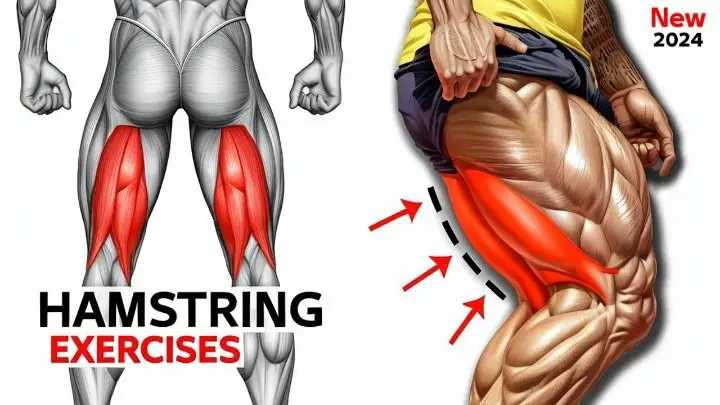Lower body pull exercises are a great way to strengthen and tone your legs and lower back muscles. These exercises focus on pulling movements that target key muscles like the hamstrings, glutes, and lower back. Whether you’re a beginner or an experienced fitness enthusiast, incorporating these exercises into your routine can help improve your overall strength and stability.
In this article, we’ll explore the benefits of lower body pull exercises, the muscles they target, and how to perform them correctly. We’ll also provide some sample workouts and tips to help you get the most out of your training.
Muscles Targeted by Lower Body Pull Exercises
When performing lower-body pull movements, the primary focus is on the hamstrings and glutes. These muscle groups play a key role in extending the hips. Additionally, the hamstrings contribute to knee flexion (bending).
Besides the glutes and hamstrings, these movements engage the erector spinae (lower back muscles), which assist in stabilizing the hips during extension. The erectors also become highly active throughout the movement, supporting the work of the glutes and hamstrings.
Glutes
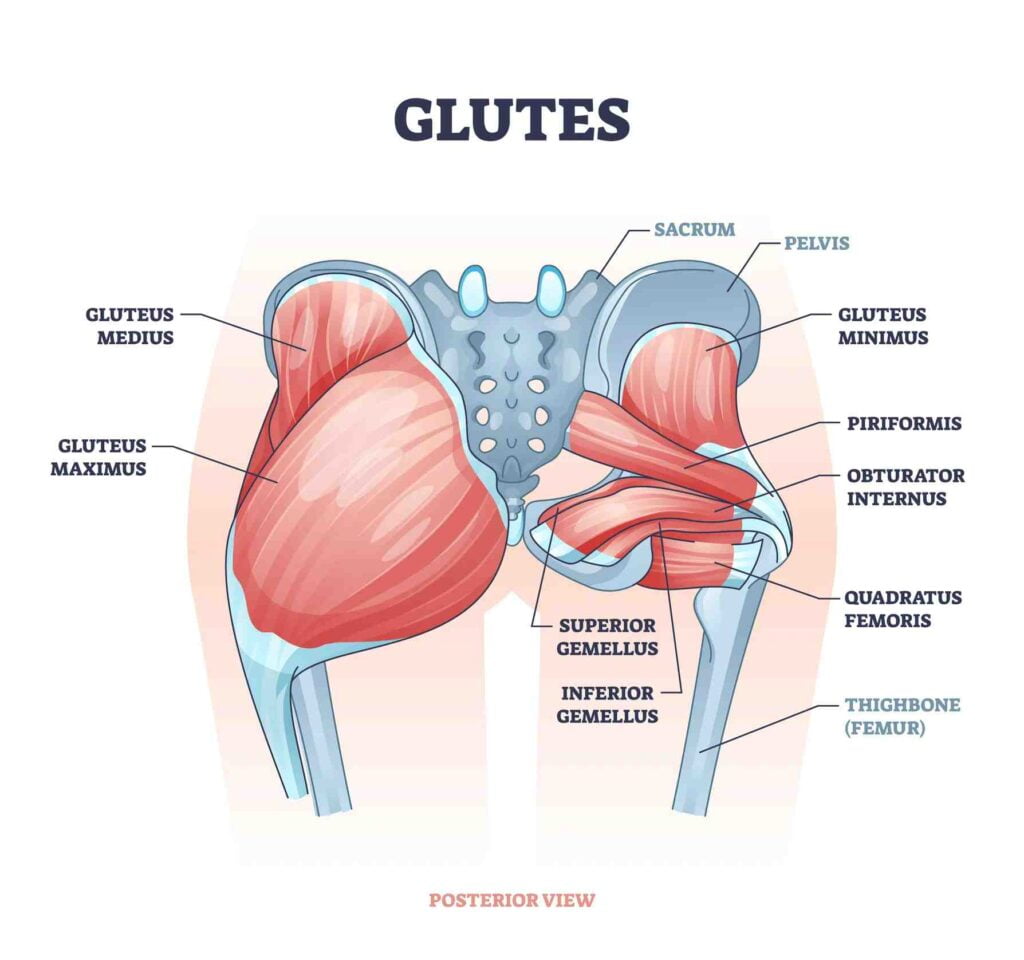
The glutes, or gluteal muscles, are a powerful group of muscles located at the back of your hips. This group consists of three muscles: the gluteus maximus, gluteus medius, and gluteus minimus.
The gluteus maximus is the largest and most superficial of the three, playing a crucial role in hip extension, which is the movement of straightening the hip joint.
The gluteus medius and minimus are smaller muscles that lie underneath the gluteus maximus and are responsible for stabilizing the pelvis and assisting with hip abduction (moving the leg away from the body) and internal rotation. Strengthening the glutes through exercises like deadlifts and hip thrusts can enhance your overall lower body strength and stability.
Hamstrings
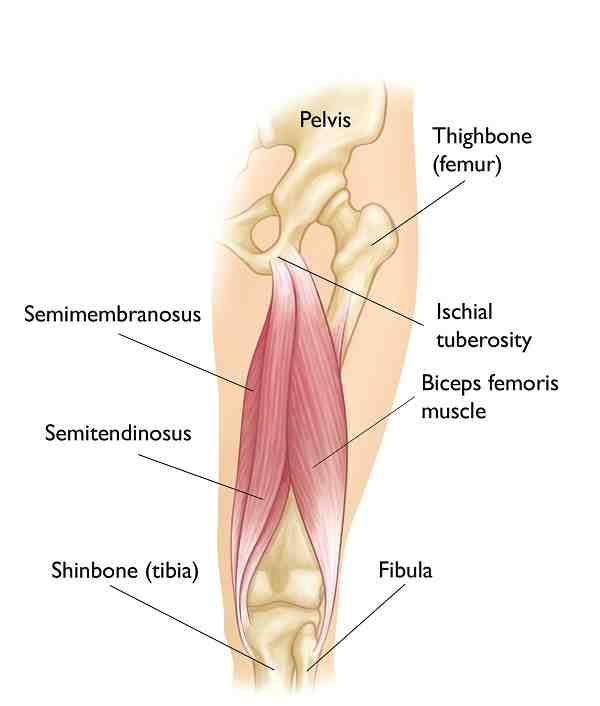
The hamstrings are a group of three muscles located at the back of your thigh: the biceps femoris, semitendinosus, and semimembranosus. These muscles are primarily responsible for knee flexion (bending the knee) and hip extension (straightening the hip).
The hamstrings work in tandem with the glutes during many lower body pull exercises, such as Romanian deadlifts and good mornings. Strong hamstrings are essential for activities that involve running, jumping, and lifting, as they help to stabilize the knee joint and prevent injuries.
Erector Spinae

The erector spinae is a group of muscles that run along the length of your spine, from the lower back to the upper back. These muscles are crucial for maintaining proper posture and supporting the spine during various movements.
Effects of Skipping Hamstring Exercises
In lower body pull exercises, the erector spinae muscles work to extend the spine and stabilize the torso, allowing for efficient and safe lifting mechanics. Strengthening these muscles through exercises like deadlifts and good mornings can help improve your overall back strength and reduce the risk of lower back injuries.
15 Best Lower Body Pull Exercises
Here are some best lower body pull exercises that can help you build strength and stability:
1. Deadlift
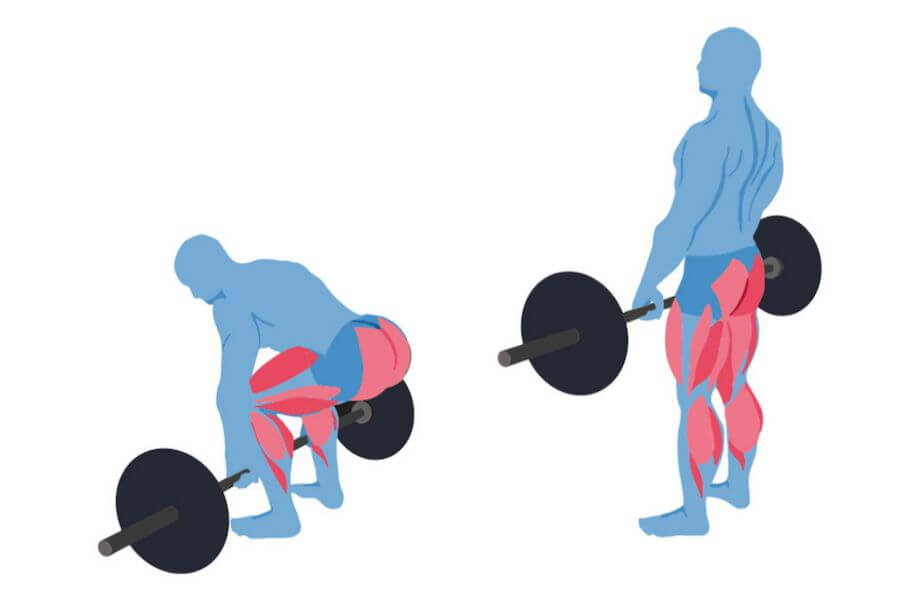
The deadlift is a fundamental exercise that targets the entire posterior chain, including the glutes, hamstrings, and lower back. It’s known for building overall strength and muscle mass. For general strength, aim for 3-5 sets of 3-6 reps.
How to Perform:
- Stand with your feet hip-width apart, toes under the bar.
- Bend at the hips and knees to grip the bar with hands just outside your knees.
- Keep your back flat, chest up, and shoulders back.
- Drive through your heels to lift the bar, extending your hips and knees simultaneously.
- Lower the bar back to the ground with control.
Tips:
- Keep the bar close to your body throughout the lift.
- Engage your core to protect your lower back.
- Avoid rounding your back to prevent injury.
2. Sumo Deadlift
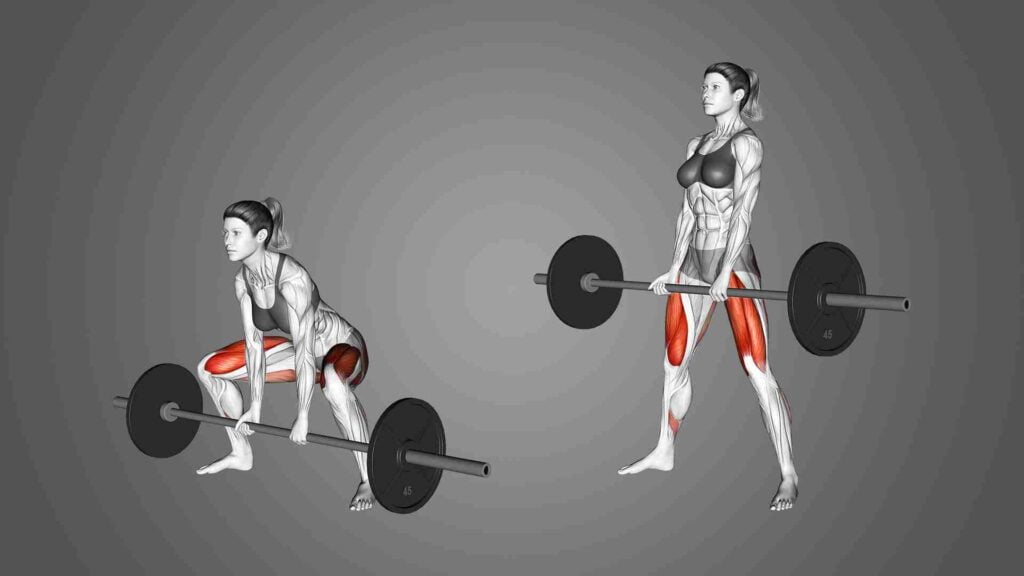
The sumo deadlift is a variation that uses a wider stance and narrower grip, reducing the range of motion and placing more emphasis on the inner thighs and glutes. For strength, perform 3-5 sets of 3-5 reps.
How to Perform:
- Stand with your feet wider than shoulder-width, toes pointed slightly outward.
- Grip the bar with your hands inside your knees.
- Lower your hips and keep your chest up and back flat.
- Drive through your heels and push your knees out to lift the bar.
- Lock out by extending your hips and knees fully, then lower the bar back down.
Tips:
- Focus on pushing your knees out during the lift.
- Keep your shins vertical to maintain proper form.
- Use a mixed grip or hook grip for better control.
3. Romanian Deadlift

The Romanian deadlift (RDL) is excellent for targeting the hamstrings and glutes, emphasizing the eccentric phase of the lift. For muscle hypertrophy, aim for 3-5 sets of 8-12 reps.
How to Perform:
- Stand with feet hip-width apart, holding the bar at hip level with an overhand grip.
- Keep a slight bend in your knees and hinge at the hips to lower the bar.
- Lower the bar until you feel a stretch in your hamstrings, keeping your back flat.
- Drive your hips forward to return to the starting position.
Tips:
- Maintain a neutral spine throughout the movement.
- Focus on hinging at the hips rather than bending at the knees.
- Avoid lowering the bar too far to prevent lower back strain.
4. Good Morning

The Good Morning exercise is excellent for strengthening the hamstrings, glutes, and lower back. It also helps improve hip hinge mechanics, which are crucial for many other lifts. For strength and hypertrophy, aim for 3-4 sets of 8-12 reps.
How to Perform:
- Stand with your feet hip-width apart, barbell resting on your upper traps.
- Slightly bend your knees and hinge at the hips to lower your torso.
- Keep your back flat and lower until your torso is nearly parallel to the ground.
- Drive your hips forward to return to the starting position.
Tips:
- Maintain a slight bend in your knees throughout the movement.
- Keep your core engaged to protect your lower back.
- Avoid rounding your back to prevent injury.
5. Straight Leg Deadlift
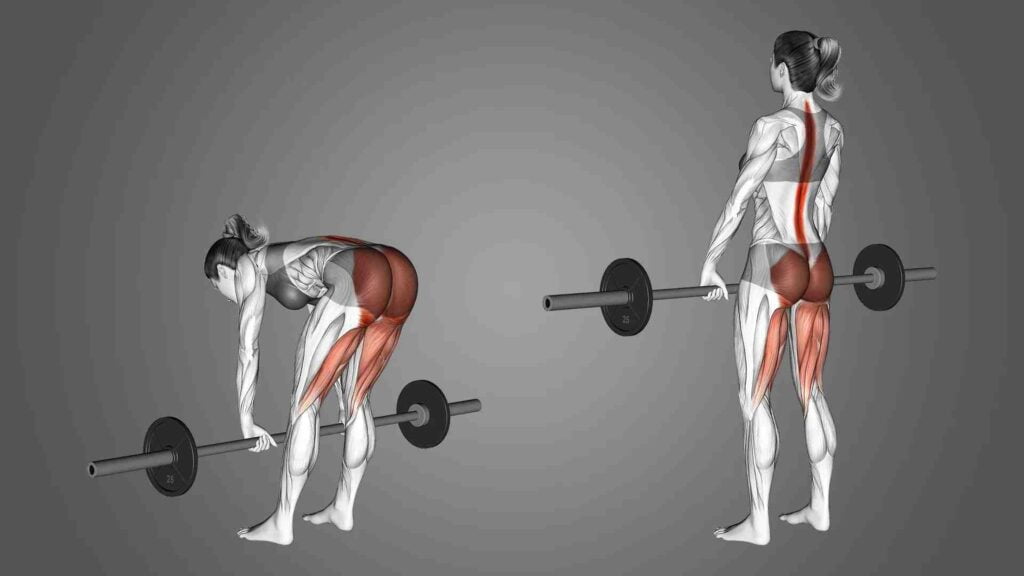
The Straight Leg Deadlift targets the hamstrings and glutes, emphasizing the stretch and contraction of these muscles. It’s a great exercise for building lower body strength. For muscle growth, perform 3-4 sets of 8-12 reps.
How to Perform:
- Stand with feet hip-width apart, holding a barbell with an overhand grip.
- Keep your legs straight but not locked, and hinge at the hips to lower the bar.
- Lower the bar until you feel a stretch in your hamstrings, keeping your back flat.
- Drive your hips forward to lift the bar back to the starting position.
Tips:
- Keep the bar close to your body throughout the lift.
- Focus on hinging at the hips rather than bending at the knees.
- Avoid lowering the bar too far to prevent lower back strain.
6. Rack Pull

Rack Pulls are a partial deadlift variation that focuses on the upper portion of the deadlift movement. They are great for building back strength and improving deadlift lockout. For strength, aim for 3-5 sets of 3-6 reps.
How to Perform:
- Set the barbell on a rack at knee height.
- Stand with your feet hip-width apart and grip the bar with hands just outside your knees.
- Keep your back flat and chest up, then drive through your heels to lift the bar.
- Extend your hips and knees fully, then lower the bar back to the rack with control.
Tips:
- Keep the bar close to your body throughout the lift.
- Engage your lats to maintain a strong upper back.
- Use a mixed grip or straps if needed for better control.
7. Glute Ham Raise

The Glute Ham Raise is an excellent lower body exercise that primarily targets the hamstrings and glutes. It’s great for building strength and muscle in these areas. For strength and hypertrophy, aim for 3-4 sets of 8-12 reps.
How to Perform:
- Secure your feet between the leg pads of a glute ham developer machine, with your knees and quads pressed against the pads.
- Contract your abs and keep your spine neutral as you lower your torso and extend your legs until you are parallel to the floor.
- Fold your arms in front of your chest or tap your hamstrings to enhance the mind-to-muscle connection.
- Contract your hamstrings and glutes to flex your legs and raise your torso back to the starting position.
Tips:
- Keep your core engaged to protect your lower back.
- Move slowly and with control to maximize muscle engagement.
- Avoid hyperextending your back at the top of the movement.
8. Single Leg Romanian Deadlift

The Single Leg Romanian Deadlift (RDL) is a fantastic exercise for targeting the hamstrings and glutes while also improving balance and stability. For muscle growth and balance, aim for 3-4 sets of 8-12 reps per leg.
How to Perform:
- Stand on one leg, holding a dumbbell or kettlebell in the opposite hand.
- Keep a slight bend in your standing knee and hinge at the hips to lower the weight.
- Lower the weight until you feel a stretch in your hamstrings, keeping your back flat and the non-working leg extended behind you.
- Drive your hips forward to return to the starting position.
Tips:
- Maintain a neutral spine throughout the movement.
- Focus on hinging at the hips rather than bending at the knee.
- Use a mirror or a spotter to ensure proper form and balance.
9. Nordic Hamstring Curls

Nordic Hamstring Curls are a challenging bodyweight exercise that targets the hamstrings and helps improve knee flexion strength. For strength and injury prevention, aim for 3-4 sets of 6-10 reps.
How to Do Dumbbell Around the World Exercise?
How to Perform:
- Kneel on a padded surface and secure your feet under a sturdy object or have a partner hold them.
- Keep your body straight from your knees to your head and slowly lower your torso towards the ground.
- Use your hamstrings to control the descent and push yourself back up to the starting position.
Tips:
- Start with a small range of motion and gradually increase as you get stronger.
- Use your hands to catch yourself if you can’t control the descent.
- Focus on the eccentric (lowering) phase to maximize hamstring engagement.
10. Glute Bridge

The Glute Bridge is a simple yet effective exercise that targets the glutes, hamstrings, and core. It’s great for improving hip stability and strength. For muscle activation and endurance, aim for 3-4 sets of 12-15 reps.
How to Perform:
- Lie on your back with your knees bent and feet flat on the floor, hip-width apart.
- Place your arms by your sides with palms facing down.
- Engage your core and squeeze your glutes to lift your hips off the ground until your body forms a straight line from your shoulders to your knees.
- Hold the position for a second, then lower your hips back to the starting position.
Tips:
- Avoid arching your lower back; keep your core engaged.
- Squeeze your glutes at the top of the movement for maximum activation.
- Keep your feet flat on the floor throughout the exercise.
11. Cable Pull Through

The Cable Pull Through is a hip hinge exercise that effectively targets the glutes and hamstrings while also engaging the lower back. For strength and hypertrophy, aim for 3-4 sets of 10-15 reps.
How to Perform:
- Set up a cable machine with a rope attachment at the lowest setting.
- Stand facing away from the machine with feet shoulder-width apart and a slight bend in your knees.
- Grab the rope between your legs and step forward to create tension.
- Hinge at the hips, pushing your butt back while keeping your back flat and chest up.
- Drive your hips forward to return to the starting position, squeezing your glutes at the top.
Tips:
- Keep your back flat and avoid rounding your shoulders.
- Focus on the hip hinge movement rather than pulling with your arms.
- Maintain a slight bend in your knees throughout the exercise.
12. Reverse Hyperextension

The Reverse Hyperextension is a great exercise for strengthening the lower back, glutes, and hamstrings. It’s particularly beneficial for improving posterior chain strength without placing stress on the spine. For strength and muscle endurance, aim for 3-4 sets of 10-15 reps.
How to Perform:
- Lie face down on a reverse hyperextension machine with your hips just off the edge.
- Hold onto the handles and let your legs hang straight down.
- Engage your core and lift your legs by contracting your glutes and hamstrings until they are parallel to the floor.
- Lower your legs back down with control to the starting position.
Tips:
- Avoid using momentum; lift your legs smoothly and with control.
- Keep your core engaged to protect your lower back.
- Focus on squeezing your glutes at the top of the movement.
13. Hip Thrust
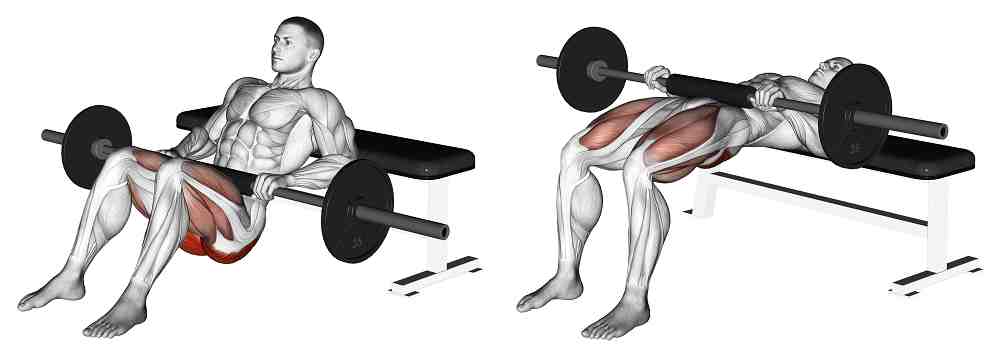
The Hip Thrust is a powerful exercise for building glute strength and size. It also engages the hamstrings and lower back. For muscle growth and strength, aim for 3-4 sets of 8-12 reps.
Effective Alternatives to Glute Ham Raises
How to Perform:
- Sit on the ground with your upper back against a bench and a barbell over your hips.
- Bend your knees and place your feet flat on the floor, hip-width apart.
- Drive through your heels to lift your hips, extending them until your body forms a straight line from shoulders to knees.
- Squeeze your glutes at the top, then lower your hips back down with control.
Tips:
- Use a pad on the barbell to avoid discomfort.
- Keep your chin tucked and gaze forward to maintain a neutral spine.
- Avoid overextending your lower back at the top of the movement.
14. Bulgarian Split Squat

The Bulgarian Split Squat is a single-leg exercise that targets the quads, glutes, and hamstrings. It also improves balance and stability. For strength and hypertrophy, aim for 3-4 sets of 8-12 reps per leg.
How to Perform:
- Stand a few feet in front of a bench, with one foot resting on the bench behind you.
- Hold a dumbbell in each hand or place a barbell on your back.
- Lower your body by bending your front knee until your thigh is parallel to the ground.
- Push through your front heel to return to the starting position.
Tips:
- Keep your torso upright and core engaged.
- Ensure your front knee does not extend past your toes.
- Adjust the distance from the bench to find a comfortable position.
15. Seated Leg Curl

The Seated Leg Curl is an isolation exercise that targets the hamstrings. It’s great for building strength and muscle in the back of the legs. For muscle growth, aim for 3-4 sets of 10-15 reps.
How to Perform:
- Sit on the leg curl machine and adjust the pad so it rests just above your heels.
- Grip the handles and keep your back against the seat.
- Curl your legs back by contracting your hamstrings, bringing the pad towards your glutes.
- Slowly return to the starting position with control.
Tips:
- Avoid using momentum; focus on a slow and controlled movement.
- Keep your hips pressed into the seat to prevent lower back strain.
- Ensure a full range of motion for maximum muscle engagement.
Product Recommendation
SHOP FOR THE ADJUSTABLE DUMBBELL SET
SHOP FOR THE RESISTANCE BAND
SHOP FOR THE BARBELL WEIGHTS ON AMAZON
Benefits of Lower Body Pull Exercises
Lower body pull exercises offer numerous benefits that can enhance your overall fitness and well-being. Here are some key advantages:
- Improved Athletic Performance: Lower body pull exercises, such as deadlifts and Romanian deadlifts, target powerful muscles like the glutes and hamstrings. Strengthening these muscles can significantly improve your performance in various sports and physical activities. These exercises enhance your ability to run faster, jump higher, and lift heavier weights.
- Enhanced Stability and Balance: By focusing on the posterior chain (the muscles along the back of your body), lower body pull exercises help improve your stability and balance. This is particularly beneficial for activities that require coordination and control, such as dancing, gymnastics, and martial arts.
- Reduced Risk of Injury: Strengthening the glutes, hamstrings, and lower back can help prevent injuries, especially in the lower back and knees. These muscles play a crucial role in stabilizing your joints and maintaining proper alignment during movement. Stronger muscles can better support your body and reduce the likelihood of strains and sprains.
- Better Posture: Weak glutes and tight hamstrings can lead to poor posture, causing you to arch or round your lower back. Lower body pull exercises help strengthen these muscles, promoting better posture and reducing the risk of developing chronic back pain.
- Increased Muscle Mass and Strength: Incorporating lower body pull exercises into your workout routine can help you build muscle mass and increase strength. These exercises engage multiple muscle groups simultaneously, leading to more efficient and effective workouts. Over time, you’ll notice improvements in muscle tone and overall strength.
- Enhanced Functional Fitness: Functional fitness refers to your ability to perform everyday activities with ease. Lower body pull exercises mimic natural movements like bending, lifting, and pulling, making them highly functional. By improving your strength and coordination, these exercises can make daily tasks, such as lifting groceries or climbing stairs, easier and safer.
- Boosted Metabolism: Engaging large muscle groups, such as the glutes and hamstrings, can help boost your metabolism. This means you’ll burn more calories even at rest, which can aid in weight management and overall health.
Should You Do Calf Raises Every Day?
By incorporating lower body pull exercises into your fitness routine, you can enjoy these benefits and achieve a stronger, more balanced body.
Sample Lower Body Workout Routine With Some of The Above Exercises
Here are some sample workout routines that incorporate lower body pull exercises. These routines are designed for different fitness levels: beginner, intermediate, and advanced.
Beginner Routine
| Exercise | Sets | Reps | Rest |
|---|---|---|---|
| Glute Bridge | 3 | 12-15 | 60 sec |
| Romanian Deadlift | 3 | 10-12 | 60 sec |
| Single-Leg Romanian Deadlift | 2 | 8-10 | 60 sec |
| Cable Pull Through | 3 | 12-15 | 60 sec |
| Hamstring Curl (Machine) | 3 | 12-15 | 60 sec |
Intermediate Routine
| Exercise | Sets | Reps | Rest |
|---|---|---|---|
| Deadlift | 4 | 6-8 | 90 sec |
| Good Morning | 3 | 10-12 | 60 sec |
| Hip Thrust | 4 | 10-12 | 60 sec |
| Reverse Hyperextension | 3 | 12-15 | 60 sec |
| Nordic Hamstring Curl | 3 | 8-10 | 60 sec |
Advanced Routine
| Exercise | Sets | Reps | Rest |
|---|---|---|---|
| Deadlift | 5 | 5-6 | 90 sec |
| Romanian Deadlift | 4 | 8-10 | 60 sec |
| Single-Leg Romanian Deadlift | 3 | 10-12 | 60 sec |
| Barbell Hip Thrust | 4 | 8-10 | 60 sec |
| Glute Ham Raise | 3 | 10-12 | 60 sec |
FAQs
Q 1. What are the best lower body pull exercises for beginners?
Ans. For beginners, exercises like glute bridges, Romanian deadlifts with light weights, and hamstring curls are great starting points. These exercises are easier to learn and help build a strong foundation.
Q 2. How often should I do lower body pull exercises?
Ans. It’s generally recommended to incorporate lower body pull exercises into your routine 2-3 times per week, allowing for adequate rest and recovery between sessions.
Q 3. Can lower body pull exercises help with lower back pain?
Ans. Yes, strengthening the glutes, hamstrings, and lower back through these exercises can help alleviate lower back pain by improving posture and stability.
Q 4. What equipment do I need for lower body pull exercises?
Ans. Common equipment includes barbells, dumbbells, resistance bands, and machines like the hamstring curl machine. Some exercises, like glute bridges, can be done with just body weight.
Q 5. Can I do lower body pull exercises at home?
Ans. Absolutely! Many lower body pull exercises can be done at home with minimal equipment, such as resistance bands or dumbbells.
Q 6. How do lower body pull exercises differ from lower body push exercises?
Ans. Lower body pull exercises primarily target the muscles along the back of the body (posterior chain), such as the hamstrings and glutes, while lower body push exercises focus on the front muscles, like the quadriceps.
Conclusion
Lower body pull exercises are a fantastic way to build strength and stability in your legs and lower back. By targeting key muscles like the glutes, hamstrings, and lower back, these exercises can improve your athletic performance, enhance your balance, and reduce the risk of injuries. Whether you’re a beginner or an advanced fitness enthusiast, incorporating exercises like deadlifts, Romanian deadlifts, and hip thrusts into your routine can help you achieve a stronger and more balanced lower body.

Good day, and welcome to Fitthour. My name is Shubham Vijay, and I am a certified personal trainer and nutrition coach with 6 years of experience in the fitness industry. At Fitthour, we specialize in types of training, such as strength training, cardio, or HIIT, and our mission is to help clients achieve their fitness goals and improve their overall health.


